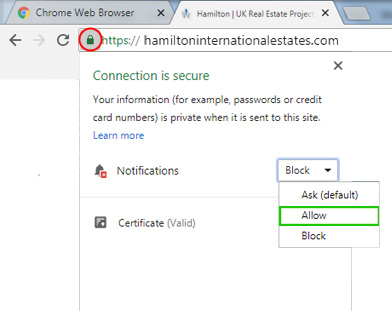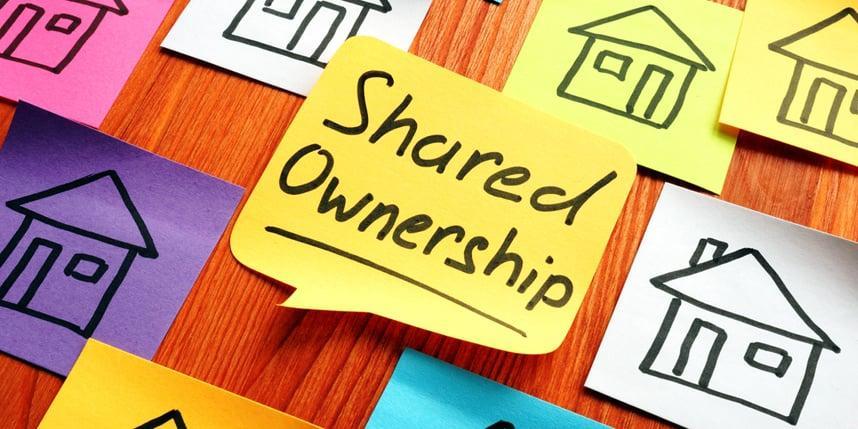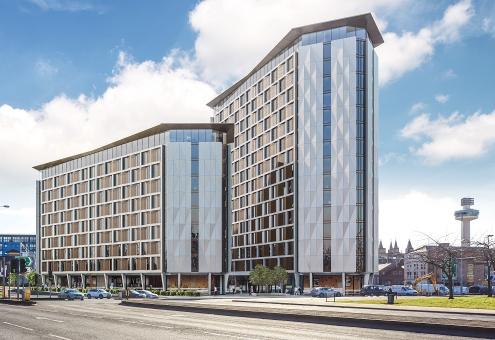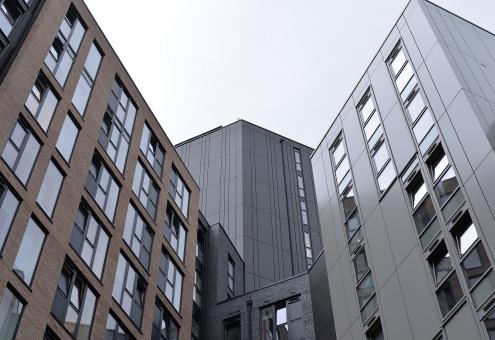What Does Shared Ownership Mean
30 Jan 2021
Introduction: - Shared ownership offers the opportunity to own a share of your home by paying a monthly amount as 'rent' on the remaining stake of the house. You start by buying in 25% to 75%, which means you may have to get a smaller deposit and mortgage to get the per cent ownership.
However, you can buy a greater share of the home in the future by working towards owning your property outright. Buying a home or property as shared ownership doesn't mean that you have to share your home with someone else, but you can apply to buy with your partner.
For example, suppose you want to buy a 25% share of a flat worth £300K. In that case, you will be paying £75K, where you will have to pay a deposit of 5% of £75,000 (£3,750) and make some monthly payments on the remaining share of the property. In addition, you pay a monthly maintenance cost/service charge, and you may have to pay a mortgage on the difference between £75,000 and £3,750.
What is Shared Ownership? How Does It Work With Example?
Shared ownership schemes are usually open only to first-time buyers. There are mostly run by housing associations supported by specific government schemes. It provides a kind of low-cost ownership that can be easier to achieve than full property ownership. In addition, since the buyer only needs a smaller mortgage, the necessary deposit is less.
So even though your mortgage repayments plus rent may be as much as (or even higher than) the repayments on the full mortgage, the need for a smaller deposit makes it easier to achieve.
In future, you can increase your ownership share in the property up to 100 per cent. If your circumstances improve, it may be possible for you to pay the remaining portion of the house price, like if you are earning more and can afford a bigger mortgage or have saved or otherwise acquired a lump sum to enable you to buy more equity.
You can usually increase your share up to three times during tenancy. For example, if you start by buying 25 per cent, you could use the staircase option to increase your share to 50 per cent, 75 per cent, and finally 100%.
The housing association will carry out a property valuation of your home when you increase your share in the property. Yet, each time you increase your share per cent, you'll also need to remortgage, for which you may need to get advice from a mortgage broker, where you may have to conduct a valuation of the house.
Although first-time buyers do not pay stamp duty, the exemption may not always apply to all such purchases.
You have two options for paying stamp duty: either you pay on the full value of the home upfront or just on the part of the share you are buying. You won't get an exemption if you choose to pay it on just a portion. However, if you opt to pay the full amount upfront, you will qualify for the exemption that covers properties worth up to £300K (or £500K in London).
Why Buy a Shared Ownership Home?
Such schemes allow buyers to get a mortgage on the stake (usually between 25% and 75%) in a property where the buyer pays rent on the share they do not own to the housing association or private developer. The rent is charged at a discounted rate (usually 2.75% of the property value per year).
Under the scheme, buying a house is made more affordable because you can start by owning just a 25% share of the property, and your deposit can be 5% of the price of that share, rather than the whole property. It is not so easy to purchase a new home or find a home for rent. While facing trouble searching for an affordable home to buy, you can go for this scheme.
In addition, you may not be asked to pay stamp duty if you increase your share to 80%.
One should know that the properties are usually leasehold properties and, therefore, you have to pay a monthly service charge and contribute to the maintenance works.
You can buy a higher share in the home by adopting the procedure of staircasing, where if you can get 10% increments in share, it reduces your rent by 10%.
Benefits of Shared Ownership
Some of the shared ownership pros and cons are given below -
You Can Afford High-End Property Too: -
Just opposite to the buying, there is no need to pay the property's full value at the time of purchase. You can even buy high-end properties through this scheme as you pay whatever money you hold as your contribution at the time of acquisition, and later on, you can pay for the remaining share to the other partner to get 100 per cent ownership.
You May Call It Your Home or Your Property: -
Like your own property, you have authority over the interior and exterior of the house, where you may decorate or modify some parts of the property. But you may have to get permission from the housing association or the partner to modify the structure.
In addition, you may have to follow the terms and conditions of the partnership agreement before you improve the interiors or exteriors. Minor changes are not a big deal, but you may require permission for major refurbishments.
Deposit: -
You deposit a share to own a percentage of the property. Getting a mortgage for a house is not easy as the lender considers your earnings, expenses, and debts to approve your application. A shared ownership UK allows you to own a house with a lower deposit.
Prospects: -
In future, you can pay for the remaining share of the house and get full 100% ownership. You can even sell your share jointly with the partner.
Safe, Secure and Trusted:-
Suppose you are interested in buying a shared ownership home; in that case, you will have to register directly with housing associations or government agencies, who will review your eligibility criteria and register your details to give you access to shared ownership opportunities in the available properties.
Step Guide -Buying a Shared Ownership Property
To buy shared ownership property UK, you must be 18 years old. There are certain income restrictions on such government schemes, as it was introduced to encourage first-time buyers and those who owned a home in the past but are no longer homeowners. The scheme is also for people already living in such homes and those who want to own them.
If you already are a homeowner, whether you have a mortgage or not, you cannot buy a shared ownership property, nor can you purchase it as a buy to let.
To become eligible for the scheme, you must earn less than £80K (£90K for shared ownership London). There are different rules for people over 55(like if you own 75% of the property, you do not have to pay rent) and disabled people (the scheme limits the share you can buy to 25% of your home). But before deciding on it, you should calculate your share using the shared ownership calculator.
You can follow the given steps –
Pick the House:-
You can get help from agencies to choose a house or survey properties in your area to select the one that meets your criteria.
Get mortgage –
You may have to get a mortgage even for a shared ownership property. But, first, you need to determine how you will be mortgaging or paying the rent.
Organise the Mortgage: -
You may have to determine a mortgage strategy for getting a shared ownership property.
Make Legal Documentation: -
Most such properties are leasehold, so you will have to pay an annual service charge, and you may have to pay other charges like ground rent and management fees. In addition, you will have to pay for the legal/conveyancing costs, valuation fee, removal cost, mortgage arrangement fee, stamp duty and home insurance.
There can be certain drawbacks to such ownerships as you are responsible for repairs and other maintenance work in the house, although you own a part of it and your rights to make home improvements may be limited.
You may have to pay the landlord a fee and get permission to make huge changes like adding a new kitchen or bathroom or other extensions. Such improvements may increase the price of the house, and you will have to pay more to buy it.
Not all mortgage lenders lend on it, so you may have to determine which lenders will loan you.
You cannot rent out or sub-let a shared property, though certain exceptions are allowed.
What Is The Difference Between Shared Ownership And Shared Equity?
Shared ownership and shared equity are the schemes for first time home buyers. Shared equity lets you borrow additional money to count towards your deposit. Then, you'll use the loan and your deposit to take out a mortgage – essentially helping you have two loans simultaneously.
1- Shared Ownership
It is an option to purchase a percentage in a property, normally up to a maximum of 80%. However, depending on the individual scheme, it can be as low as 10% with the option of 'stair-casing,' i.e. gradually purchasing a higher proportion when affordable.
Shared ownership eligibility criteria are that you could buy a home through the scheme in England if the household earnings are less than £80K per annum (or £90K per annum or less for shared ownership London).
For example, you are an owner-occupier, and your financial conditions changed through redundancy or health problems, which means you may no longer be able to meet the costs for your current home, and you are selling. Or if you are moving to the area for employment or receiving family support. There is a process that you need to go through to go ahead and buy your new home.
Based on a rental/ownership agreement, a buyer can jointly own a property with a housing association or property dealer based on a rental/ownership agreement. Normally, it would also include the management costs, for example - Buildings Insurance. And they get an option to get full ownership in future by paying for the 100% of the property.
The benefit of the scheme is that the applicants have the security of knowing that they own part of the residential property. Also, there are certain Government schemes offered to buyers through 'Help to Buy', where one can get an interest free loan for the first five years and then a proportion of the interest is gradually built up over time.
2- Shared Equity
For several years, shared equity schemes have been a feature of the mortgage market. Housebuilders and local authorities have primarily offered such schemes as part of the government initiatives to help first-time buyers onto the property ladder.
It allows the homebuyer to combine a small deposit with a lower-than-average mortgage size where you get an 'equity loan', covering a part of the house value.
You may repay the equity loan after many years in parts or in full or when you sell the property.
The value of your equity loan fluctuates with the value of your property. So the amount you'll pay depends on the property's value when you repay.
Conclusion: If property buying is in your cart and you face problems getting a mortgage from financial institutions, you can go for shared ownership. Housing associations or private developers provide shared ownership schemes.
However, the details, the eligibility criteria, costs and restrictions on such agreements vary by provider, so one should analyse each one on its merits and read the small print of the lease to determine if they wish to buy it or not.
Categorised in: All News












